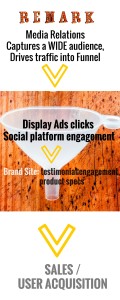The New PR 101: Don’t Confuse Influencers With Journalists
How scammers are taking advantage of the changing media landscape to blur the lines of journalistic integrity
One of my favorite things about human nature is our ability to adapt and evolve. In the PR industry, our evolution has been predicated mostly by the changing media landscape starting with the switch from print to digital that began almost two decades ago (and a little bit by Google Analytics). The latter topic I’ll save for another article because what I really want to focus on in this piece is how we, as Media Relations professionals, have adapted to the era of the Influencer.
While often owned by social media and/or PR teams, the influencer isn’t necessarily a blogger or a writer or even a professional photographer. Often this person has developed and grown a successful brand for themselves on a social platform. As a crazy pug person, I’ll offer up Doug the Pug as an example of this.
Sometimes, it seems like the era of the social media influencer, similarly to the era of the blogger circa 2007, has become a Wild West free-for-all while lawmakers and key players in the space struggle to catch up. What standards and responsibilities fall to Joe Smith with a large Instagram following when he shares a picture of his favorite beer brand? He may have been paid by the brand or he may just be sharing his happy hour beverage of choice.
Is it common practice for PR and social media representatives to pay an influencer to post about a brand? Yes. Many of our clients have budgets for these folks. Does the lady responsible for Doug the Pug get paid by Netflix to produce videos promoting its original series Stranger Things? Probably. And that’s fine. What’s not fine is when the lines become blurred between Influencers and Traditional Journalists.
One of the inspirations for this post came this past holiday season when my team responded to a HARO query from a Buzzfeed Contributor. The Contributor was looking for best-in-show products for his 2017 Holiday Gift Guide roundup. One of my PR Coordinators responded to his query and was excited when she received the news that yes, Buzzfeed would feature our client in the gift guide pending a product sample. Done and done. When the article went live, it was indeed on Buzzfeed and was the longest Gift Guide I had ever seen. The Contributor listed about 250 products grouped by category; to find our client I had to scroll continuously for five minutes. I didn’t even want to share this piece of junk coverage with our client and wasn’t surprised two days later when the Gift Guide was wiped from the Buzzfeed site altogether.
Something felt fishy so I decided to investigate this Contributor a little. That’s when I came across a Cracked.com article written by the would-be Buzzfeed Contributor titled “How I Used Fake Reviews For Tons Of Free Crap”. In it, he described in detail how he successfully scammed companies – from those on the Fortune 500 list to entrepreneurs crowdfunding their first product. And the even crazier thing is that he didn’t just scam the PR people representing these companies, he scammed legitimate media outlets into giving him a platform. Explains Brian Penny:
“I was given the latest phones, laptops, speakers, IoT tech, headphones, the finest whiskies, wines, and rums, music instruments, baby gear, jewelry, vape pens, cameras, appliances, collectibles, home furnishings, camping gear, drones, clothes, even food. Overall, I was able to sell over $3,000 worth of merchandise on eBay, and made another $2,000 on Craigslist.”
“I continued pushing the boundaries and skipped the “review” process entirely, simply collecting products into “gift guides” and other listicles. HuffPost loves listicles, and the PR people couldn’t have cared less how they were featured, as long as they got that anchor link.”
It wasn’t just products for posts either, Brian Penny also found that eager brand representatives would pay him to simply post pre-written articles on his HuffPost contributor platform without lifting a finger or changing a word.
“I responded to a handful of offers explaining that I would happily post an article on HuffPost, but it had to be written for me, and I wouldn’t do it for less than $150.”
To my surprise, one very eager SEO consultant responded with several articles written and ready to post. I ran with it and put out feelers for more, gradually increasing my asking price each time to $200, $250, $300. By the end of one month, I was making $500 a pop to post articles I had nothing to do with. I did about a dozen of these articles in total, and made about $4,000 in 90 days. The articles were well-written, so the interns on the {HuffPost) blog team had no reason to question why a guy who’d previously blogged about whistleblowing was writing articles about Blake Shelton’s Pepsi concert series, artificial grass, or VOIP phone services.”
It turns out that Brian Penny isn’t the only imposter, he’s just loud and proud. The Outline published a full investigation describing how brands secretly buy their way into Forbes, Fast Company and HuffPost. Author Jon Christian writes:
“People involved with the payoffs are extremely reluctant to discuss them, but four contributing writers to prominent publications including Mashable, Inc, Business Insider, and Entrepreneur told me they have personally accepted payments in exchange for weaving promotional references to brands into their work on those sites.”
This practice is not only misleading and illegal but it discredits distinguished publications that employ award-winning journalists. It also further threatens the entire media landscape in the era of ‘fake news’. These top tier publications don’t hesitate to take swift action against people on their staff who are caught accepting payment for coverage. Jason Feifer, editor in chief of Entrepreneur, was quoted in an email to The Outline stating:
“We have a zero-tolerance policy for this kind of thing, our writer’s guidelines strictly prohibit it, and we take swift action. In the past, when alerted to people selling access on our site, I’ve even gone the extra step of alerting editors at other publications where that person writes, so that these bad actors have nowhere else to go. We value our readers’ trust above all, and will always work to ensure that they’re getting unbiased information from people who have their best interests in mind.”
As PR professionals we too, should hold ourselves to the same standards as our editorial contacts are held. If someone at a reputable publication requests payment for posts, we should report that person. It’s also our job to know the difference between a self-employed influencer who can accept payment and a writer who is bound by his or her journalistic integrity to report objectively to the public.
Lastly, we’re human and we’re extremely busy. We tend to trust queries distributed through HARO ( the e-newsletter service owned by leading PR software platform Cison) and we also trust that a writer for Buzzfeed or Fast Company has been vetted by the editor at said publication. My goal in writing this is to bring some awareness to an opaque practice that is bad for business and encourage readers to put in some due diligence (at the very least a quick Google search never hurts). After all, our clients’ are trusting us to be the stewards of their brands. At the end of the day, I’m a huge proponent of the PR industry adapting and embracing new mediums for targeted, effective brand exposure but hopefully not at the expense of the credibility of traditional journalism.

